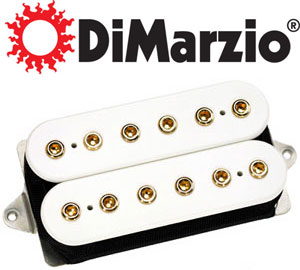Q&A: DiMarzio’s Steve Blucher On…
…the new Gravity Storm pickups designed for Steve Vai, and a bit o’ other stuff. Why other stuff? Because the second-best thing to playing guitar is talking guitar.
Thanks much to Steve Blucher – DiMarzio’s pickup guru, in case you didn’t know – and DiMarzio for setting this up. So much for the preamble:
WoodyTone: With Steve Vai’s colorful way of talking about what he wanted in this pickup [“a thundering cloud of ice cream”], how did you interpret that technically?
Steve Blucher: This time it wasn’t too hard. In the old days, he used to kind of geek out on technical talk – the frequencies he wanted punched up and pulled down – and he didn’t do that this time.
He basically said he wanted to go away from where he was before. He said he wanted the warmest, fattest-sounding pickups possible, and didn’t really care about output level too much. I asked if he wanted them to be as loud as the Evos [DiMarzio Evolutions], and he said not necessarily – he was just looking for the tone.
That was about it, actually. I made I think four sets of pickups, loaded them all in Jem pickguards and sent them to him.
WT: Then what?
SB: He’s very disciplined about [testing]. What he usually does is in his home studio when he’s checking out a piece of equipment, he’ll run through a preconceived song and set of licks and record it. Then do the same thing again and A-B everything.
He’s one of the great double-track guys of all time. He can play the exact same passage exactly the same way 50 times. There are very few guys like that.
What he usually does when he’s recorded them all, he comes back the next day when his ears are clear, listens to the results and decides what he likes. And that’s what happened this time.
WT: In your opinion, how different are these pickups vs. the Evos?
SB: The bridge pickup is night and day different. It’s a lot fatter, and is pretty much a medium-output pickup. The Evo is pretty much high output.
I always thought the Evo was a pretty nasty, in-your-face pickup: Just basically breathing on the thing with an overdriven amplifier, it immediately decides it wants to get to the next harmonic. The Gravity Storm is a lot more about fundamental tone.
The neck [Gravity Storm] is not a radical departure from the Evo neck model. It’s medium output. We could have made it fatter – some of the others were fatter – but he picked the one he liked, and as far as I’m concerned, he picked the good one. It’s not fat so much as warm and friendly.
WT: Were you surprised by his change of direction?
SB: I’ve been following the development of [Vai’s signature Carvin] amplifiers, and those have been going through sort of a similar thing: The newer one has a broader tonal range than the original one.
I just wanted him to be sure that when he plays songs spread out over 25 years of recorded material, the pickups would be able to do the entire range of the material – because the bridge pickup was in the other direction [vs. the Evos]. He said, “Yeah it’s cool.” When I heard that, then I could relax.
WT: Why the Alnico V magnet in the bridge?
SB: The classic, cliche formula is that Alnico is warmer and friendlier than ceramic. But I can make a pickup with a ceramic magnet and you’d never know it was ceramic. Having said that, it was just that warm, friendly thing I thought he was looking for, and the fact that we didn’t need to make the pickup loud.
There are so many choices when you make a pickup, and…it’s more instinct than anything else at this point.
I wanted to do the Alnico thing [in the bridge], but the neck pickup [needed to be] fat enough for a smooth transition. Some people don’t want a smooth transition [between the neck and bridge tones], but I didn’t get that sense from him. I got the sense that all the sounds were supposed to pull together on this one. [Steve noted that the single coil-sized middle pickup Vai uses also is different than the Evos.]
I didn’t want the neck pickup to be warm to the point of being muddy, and one way to make sure that doesn’t happen, particularly on the low end, is to use ceramic – because one of the things it does easily is articulates well.
WT: The bridge pickup – I don’t know how to describe it except it’s very balanced and loud in the low strings but not at all woofy or boomy. Was that intended?
SB: Yes. I didn’t want either of them to fart out on the low end. That would be deadly. Having said that, I can see where you wouldn’t necessarily want to put that pickup in a lot of Les Pauls. There’s good Les Pauls and bad Les Pauls, but you wouldn’t want to put a fat pickup in a guitar that acoustically is very tubby sounding.
If you have a guitar with a floating bridge, a guitar like Steve plays, those guitars EQ out a little low end in the first place.
WT: The Gravity Storm neck is a complete masterpiece in my opinion. It sounds different everywhere on the neck – I never knew a pickup could do that. In the guitar I have it in, an SG copy, it sounds like a Strat or Tele neck pickup when I’m down low on the fretboard and way up high, but it’s like a Les Paul neck pickup around the 11th to 15th frets. How does that happen?
SB: Stuff like that is not deliberate. but the two coils are tuned to different frequencies. That’s a trick I’ve been doing for a very long time, and when you do that, different things pop out of the strings at different places frequency-wise.
That pickup is fat but has some funny single-coil overtones going on. It’s got “big ears” – it hears the string well. It gets a lot of information from the strings. It doesn’t tend to find one thing from the strings and exclude everything else. If you try it on a longer-scale guitar, I think you’ll have way more fun.
The other thing is both [Gravity Storm pickups] do coil-splitting very nicely. They both do it better than the Evos ever did.
The thing about the Evos – for somebody who perhaps was not an accomplished player, the entire Evo set was not always easy to play. They didn’t exactly play themselves. These pickups are friendlier, more fun.
WT: I’ve fallen back in love with DiMarzio pickups. I was on the vintage bandwagon for a while, but DiMarzio pickups have that vintage base and this indefinable “something else” I realized I missed. Do you think that’s a fair characterization?
SB: That’s a hard one to answer. My problem is I’ve designed an awful lot of pickups…. I try to be as objective as possible, but I worry about stepping out of my own head and walking away from my own ears. I wonder if they’re too similar to each other, like it’s all inbred, you know?
I hope that’s not the case. I’ve heard people say there’s the DiMarzio sound, the Duncan sound, the EMG sound, they can always tell. But we have pickups that don’t sound like each other – they’re radically different.
I like to think in the last 10-20 years I haven’t let pickups out the door that don’t do what they’re intended to do. I don’t know how else to say it. I hope they’re not all so similar, so recognizable.
My .02
First of all, I’m just an armchair tone nut. My opinion and $10.00 will get you a beer at Yankee Stadium. That said:
I’ve played several DiMarzio pickups, but few compared to what Steve has created over the last 30 or so years. I also only really play classic rock-style stuff, so I’m most concerned with going for those tones. And…
…I do believe the DiMarzios I’ve played ARE similar, but maybe only because they’re different than everything else.
















I own and have built 100s of guitars, but for quite a number of years my favorite guitar still remains with DiMarzio X2N in the bridge and Air Norton in the neck. When you use them you quickly learn how having tone and volume controls make a lot of sense. Simply the best.